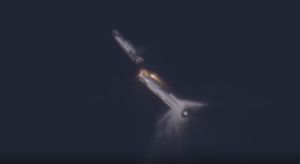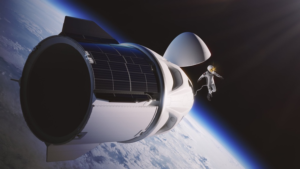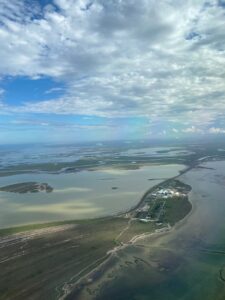
SpaceX Fires 31 of Super Heavy’s 33 Engines For The First Time
SpaceX has been developing and testing Starship rapidly for years now. What started with small hops using Starhopper and SN5, has now become some of the most powerful rocket tests in the world. Down in Boca Chica, Starbase has been working in overdrive as they continue to make progress on Starship’s first orbital test flight.
Yesterday one of the most significant developments toward this goal was completed with the first almost full booster static fire. In total, Super Heavy features 33 engines and SpaceX reported that 31 fired for around 5 seconds. This being said, the results were almost perfect which is a very big deal, especially considering the risks of testing such a powerful rocket.
Various footage and drone angles from SpaceX highlight the power and strength of this rocket stage and the Raptor engine. With this test complete, there are only a few final steps necessary before the first launch of Starship. Depending on the detailed results of this static fire, a maiden flight only months away is very possible. Here I will go more in-depth into yesterday’s static fire, what this means for the program, what to expect in the coming weeks, and more.
31 Engine Static Fire

Yesterday afternoon SpaceX for the first time ever attempted a full Super Heavy static fire with Booster 7. SpaceX first tweeted saying, “First static fire attempt of 33 Raptor engines on Booster 7.” They also clarified in another tweet that the amount of time the engines fired was “Full duration”. Thanks to multiple different camera angles including a drone shot, you can see exactly how much power these engines produced. From the vertical view, you can see the massive fire plume being redirected in 6 different directions between the legs of the orbital launch mount. From the ground angle, it only takes seconds for the camera and the entire launch site to be covered by smoke and dust.
Based on the footage alone the test seemed to have gone very well. For one, the booster did not explode which is a great sign, and two, it looked as if all the engines began at the same time without any anomalies. Soon after Elon Musk tweeted clarifying, “Team turned off 1 engine just before start & 1 stopped itself, so 31 engines fired overall. But still enough engines to reach orbit!” The orbital launch mount (OLM) also looks to have survived the test which is a big deal in itself. This system helped hold Starship down with 20 clamps to counteract any remaining thrust. What’s most exciting is the fact that this test, while not 100% confirmed, would mean Sueprheavy takes the throne as the most powerful launch vehicle ever fired using the most engines ever fired at once.
At full power, Super Heavy’s 33 Raptors produce about 16.5 million pounds of thrust. Each Raptor 2 engine can generate up to 230 tons (507,000 lbf) of thrust at sea level. On the other hand, Raptor is designed to throttle as low as 40%, or 92 tons (~200,000 lbf) of thrust. All this being said, it would make the most sense for the company to test as close to full thrust as they are conformable with as they prep for an orbital test flight.
What’s Next?

Now that we know more about yesterday’s test, we can take a closer look at what the next steps are before the long awaited orbital test flight. The first big question is whether or not this test satisfied SpaceX’s goals and expectations. As we know, two of the Raptor engines did not fire due to various reasons. In this case, there are a few different possible scenarios. It’s possible that despite these two engines not firing, SpaceX knows why and is confident that a replacement of the two to be safe would do the job going forward. It’s also important to point out that the company can afford to lose a few engines during an actual launch and still reach orbit, as Elon highlighted in his tweet.
The other option however is additional testing in the near future. Only days ago president of SpaceX Gwynne Shotwell said, “Tomorrow is a big day for SpaceX. We are going to attempt a 33-engine static fire booster test for Starship. It’s really the final ground test that we can do before we light ‘em up and go.” She also said, “That first flight test is going to be really exciting. It’s going to happen in the next month or so.” This was referring to what would happen if the test was fully successful. Overall, it seems that Shotwell tends to take a somewhat of a slow and steady approach relative to SpaceX standards. This favors additional testing to make sure that everything is perfect before the first launch attempt.
Focusing back on yesterday’s test, the Super Heavy booster was not the only thing that performed very well. The infrastructure at Stage 0 also looks to have held up extremely well especially when you consider the forces applied to it during that test. In the past, SpaceX would static fire Starship and concrete, and various materials would fly all over the place thanks to the power of the Raptor engine. This really highlights the amount of work done by the teams at SpaceX to reinforce and prepare the necessary systems. While it’s not perfect quite yet, and some of this concrete rain can still be seen, it’s a very big improvement considering what it just went up against. This has to do with a new type of concrete that was poured under the rocket. Called, FONDAG, it’s a pre-blended, high strength, heat resistant concrete designed for heavy industrial applications. The mixture is a pure calcium aluminate concrete which contains both calcium aluminate cement and calcium aluminate aggregates. This helps it withstand much more heat and pressure compared to regular concrete.
Going forward, a launch in March is optimistic and about as soon as the company could even try. This has to do with everything I’ve talked about and more. The water deluge system for example is a big topic relating to the first launch. While this system would no doubt help reduce the damage and projectiles during a launch, SpaceX has a few options. Right now the company is not necessarily aiming for fast reusability and constant launches. They are trying to get Starship into orbit for the first time. If the pad gets damaged after a launch attempt they would have plenty of time to fix the concrete and various issues before the next attempt. Going forward, however, a system will need to be in place to ensure both the pad and rocket are in almost perfect condition soon after launch.
For the upcoming launch, you also have to consider the FAA. Currently, Starship can’t fly until the Federal Aviation Administration approves a launch license. In this case, they may deny SpaceX a license without a perfect 33-engine static fire. Ideally, the FAA could accept that Starship would be able to safely launch and reach orbit while missing several Raptors. If the results are what SpaceX wanted, Ship 24 will then be transported back to the pad and reinstalled on top of Booster 7. From here, SpaceX might conduct another wet dress rehearsal or a static fire with the fully-stacked Starship, but it may also deem additional testing unnecessary.
As we know, Starship is working to become the world’s most powerful launch vehicle ever developed, with the ability to carry up to 150 metric tonnes to Earth orbit reusable, and up to 250 metric tonnes expendable. Powered by 33 Raptor engines fueled by sub-cooled liquid methane and liquid oxygen (CH4 / LOX), Super Heavy is fully reusable and will re-enter Earth’s atmosphere to land at the launch site. Starship is the fully reusable spacecraft and second stage of the Starship system. The vehicle offers an integrated payload section and is capable of carrying passengers and cargo to Earth orbit, planetary destinations, and between destinations on Earth.
Relating to yesterday’s test, the Raptor engine in particular has had an interesting yet important history. The engine is a reusable methalox staged-combustion engine that powers the Starship launch system. Raptor engines began flight testing on the Starship prototype rockets in July 2019, becoming the first full-flow staged combustion rocket engine ever flown. In July 2021, SpaceX announced that they would be building a second production facility for Raptor engines, this one in south Texas near the existing rocket engine test facility. By late 2021, SpaceX said that scaling Raptor production to support the frequent Starship test program planned for 2022 was “currently the biggest constraint on how many vehicles we can make” and that failing to achieve a flight rate of at least once every two weeks by late 2022 would open up the possibility of bankruptcy for SpaceX. The reason given was that Starship’s orbital launch capability is necessary to deliver the next generation Starlink satellites needed to operationalize the massively capital-intensive Starlink broadband internet constellation.
Conclusion
For multiple years now SpaceX has been working at Starbase to develop, manufacture, and test a next generation launch vehicle meant to change how we access space. Yesterday we watched one of the most significant tests yet with an almost full 31 out of 33 engine static fire of Booster 7. Overall the test was considered a massive success and likely broke multiple thrust records. In the coming weeks, we can expect more information from SpaceX which will determine whether or not more testing is necessary or if final launch prep will begin. We will have to wait and see how it progresses and the impact it has on the space industry.



